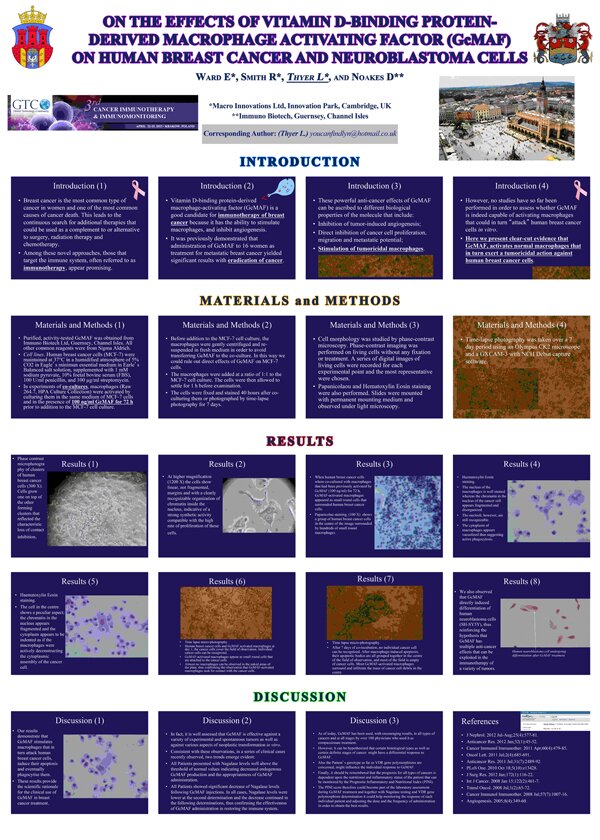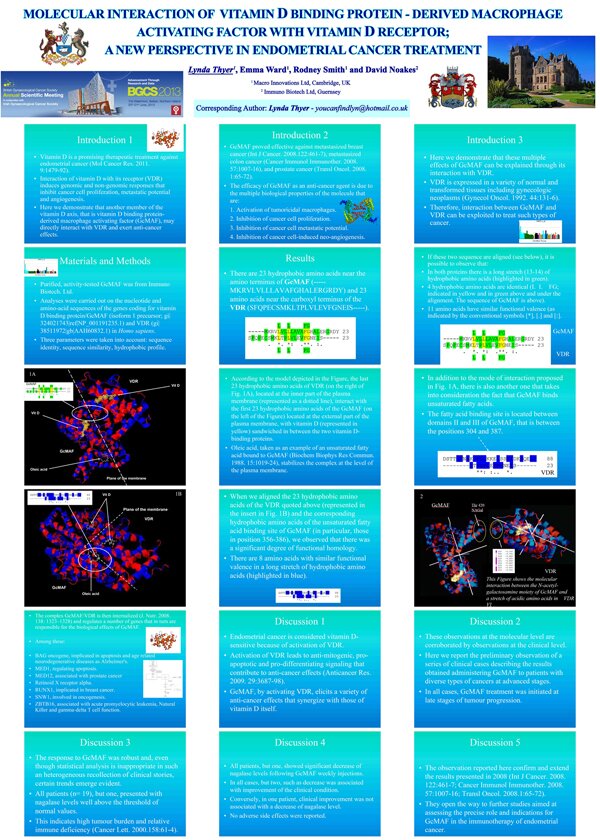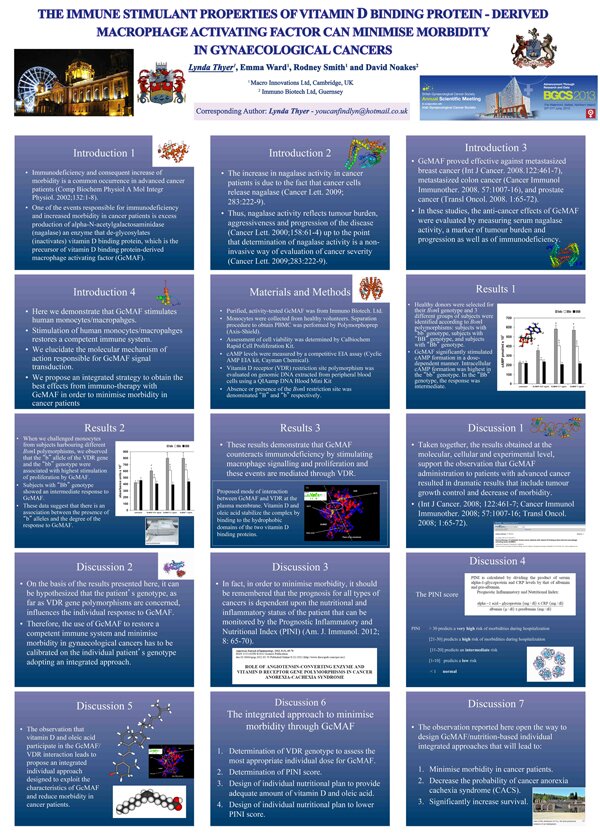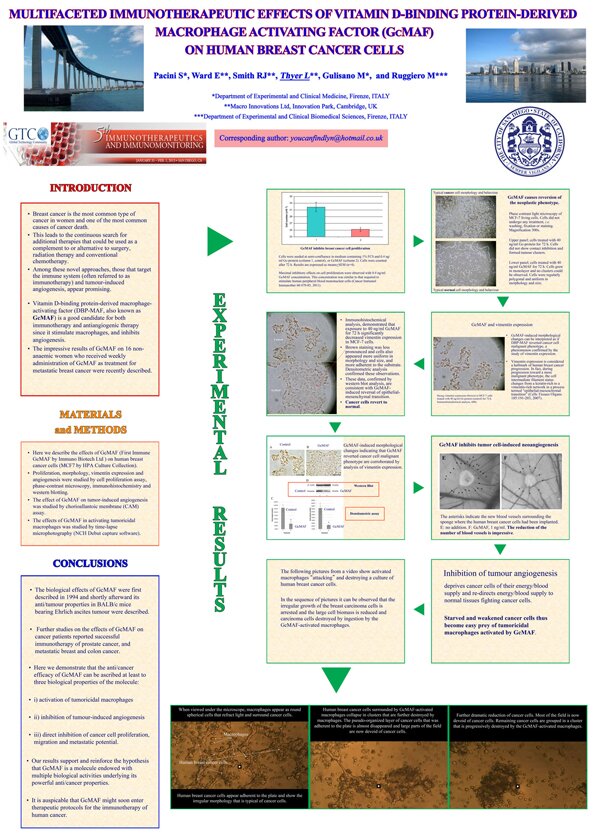







In 2013 we submitted no less than 16 scientific research papers or posters Our first in 2014 was available on the 2nd January. All have been peer reviewed, accepted and published in prestigious scientific journals or immunology conferences. One is on the front cover of the prestigious scientific journal Oncolmmunology, and our paper on GcMAF and cancer cell apoptosis is in the top 5% most read scientific papers of all time.
- Clinic Posters
- Clinical results
- Autism recoveries
- 16 in 2013
- Krakow
- 1st Belfast
- 2nd Belfast
- USA & Dubai
- San Diego
- Nutrients
- Clinical 1- Oncolmmunology
- Clinical 2- Immunology
- Frontiers in Immunology
- Clinical, Italy
In May 2014 two additional studies describing our successful approach to cancer treatment (25% tumour shrinkage per week) have been accepted for presentation after exhaustive peer-review by a prestigious Scientific Committee. The Scientific Committee of the IX National Conference of the Italian Society of Immunology, Clinical Immunology and Allergology, accepted two studies of ours reporting our most recent successes in cancer treatment with Oleic-Acid-GcMAF (Goleic).
The dramatic results were presented to an international audience of Medical Doctors and Researchers gathered in Florence, Italy on May 28-31. The Conference was under the Patronage of the European Federation of Immunological Societies, the European Academy of Allergy and Clinical Immunology, the National Federation of the Italian Medical Associations, the Municipality of Florence, and the main University Hospital of Firenze (AOL Careggi). The patronage of such distinguished medical and scientific societies and institutions testimonies the international prestige of the Conference and, consequently, of the presented studies.
The first study, authored by Ward, Smith, Branca, Noakes, Morucci and Thyer, describes the successful integrative approach based on Goleic in cancer patients defined as incurable. The actual images of tumours shrinking on average 25% in one week were clearly presented and they received the appreciation of the highly qualified audience. We were particularly proud to show the images of a pancreas adenocarcinoma, one of the most rapidly lethal cancers, that not only shrunk in size, but is eventually became encapsulated, de facto turning into a benign tumour.
Click here: Clinical results with Goleic
The other study, authored by Ward, Smith, Branca, Noakes, Morucci, Pacini, Ruggiero and Thyer, describes the molecular mechanism of action at the basis of such stunning results. Here it is demonstrated that Goleic induces the synthesis of a powerful anticancer molecule that is called nitric oxide that in turns kills cancer cells, thus contributing to cancer eradication. With these results, we demonstrate another attack of Goleic on cancer that was not known before. This study is at the basis of a full paper that we aim at publishing in one of the most prestigious, peer-reviewed, scientific journals listed in the database of the National Library of Medicine of the National Institutes of Health of the USA.
Click here: Molecular mechanism and spleen
The first paper on the results in our Treatment Centre has been published.
The highlights of the results section include an average tumour reduction of 25% a week, and before and after ultrasonography scans of tumour shrinkage with measurements. Patient 3 is the most representative with a 27% reduction, and four other patients (not shown) with similar results. All 26 patients showed significant clinical improvements.
doi:10.3844/ajisp.2014.23.32 (http://www.thescipub.com/aji.toc)
Our second major autism recovery breakthrough
Our Scientific Director, Professor Marco Ruggiero, and our good friend Dr Jeffrey Bradstreet, have discovered the main place in the brain where autism resides, and written a research paper, peer reviewed and published in Frontiers in Human Neuroscience, part of the prestigious Nature Publishing Group. The solidity and credibility of these results are beyond question:
“A new methodology of viewing extra-axial fluid and cortical abnormalities in children with autism via transcranial ultrasonography”
http://www.frontiersin.org/Journal/10.3389/fnhum.2013.00934/abstract
This paper is probably the most major milestone in autism research.
For the very first time in autism history, clearly evident anatomical alterations in the autistic brain can be easily detected, measured and classified. The diagnosis and the follow-up of autism will no longer be based on subjective clinical observation, but on solid, indisputable data.
This technique will also allow diagnosis, as early as 3 months of age, the future development of ASD with consequent, significant possibilities to intervene and possibly avoid and/or revert the onset of autism.
There is no doubt Transcranial Ultrasonography is a useful screening technique for children at potential risk of ASDs.
Since ALL children are now at risk from autism (one in 50 contract it), in our opinion this exam should be performed on ALL newborn babies between the age of 3 and 6 months in order to prevent the onset of ASD.
If this exam is performed correctly and on the proper scale, we may surely state that we shall be able to revert the course of this epidemic and prevent the burden of sufferance that you know all too well.
Currently there are only two centres in the world where such a technique is practised: Dr Bradstreet’s Brain Treatment Centre in the USA and our own Treatment Centre in Switzerland.
Last, but not least, this technique will also allow us to monitor the efficacy of therapies in a very objective and indisputable manner.
Dr Bradstreet discovered our first autism breakthrough, namely that our GcMAF is easily the lead therapy in autism: 85% of children improve and 15% made full recoveries, although with Goleic that figure is now 25%.
Here is perhaps the most important part of the new paper:
Results: Comparisons of the extra-axial spaces indicated increases in the ASD subjects. For EAF we scored based on the gyral summit distances between the arachnoid membrane and the cortical pia layer (subarachnoid space): 1) < 0.05 cm, 2) 0.05 – 0.07 cm, 3) 0.07 – 0.10 cm, 4) > 0.10 cm.
All of the neurotypical siblings scored 1, whereas the ASD mean score was 3.41 (plus or minus 0.67.)
We also defined cortical dysplasia as the following: hypoechoic lesions within the substance of the cortex, or disturbed layering within the grey matter. For cortical dysplasia we scored: 1) none observed, 2) rare hypoechogenic lesions and/or mildly atypical cortical layering patterns, 3) more common, but separated areas of cortical hypoechogenic lesions, 4) very common or confluent areas of cortical hypoechogenicity. Again all of the neurotypical siblings scored 1, while the ASD subjects’ mean score was 2.79 + 0.93.
List of 25 peer-reviewed scientific publications that use our GcMAF
16 have been produced by Immuno Biotech Ltd.
2011
1. Gc protein-derived macrophage-activating factor (GcMAF) stimulates cAMP formation in human mononuclear cells and inhibits angiogenesis in chick embryo chorionallantoic membrane assay.
Pacini S, Morucci G, Punzi T, Gulisano M, Ruggiero M.
Cancer Immunol Immunother. 2011 Apr;60(4):479-85. doi: 10.1007/s00262-010-0953-7. Epub 2010 Dec 14.
Here it is demonstrated that GcMAF from Immuno Biotech Ltd is as effective as Dr. Yamamoto’s GcMAF in inhibiting angiogenesis, a key event in tumour progression.
2. Effects of Cadmium and vitamin D binding protein-derived macrophage activating factor (DBP-MAF) in human breast cancer cells.
Massimo Gulisano, Tiziana Punzi, Gabriele Morucci, Marco Ruggiero.
It. J. Anat. Embryol. Vol. 116, No 1 (Supplement) 2011.
Here it is demonstrated that GcMAF counteracts the noxious effects of Cadmium, an ubiquitous heavy metal pollutant involved in autism, chronic fatigue syndrome and neurodegenerative diseases.
2012
1. Effects of vitamin D-binding protein-derived macrophage-activating factor on human breast cancer cells.
Pacini S, Punzi T, Morucci G, Gulisano M, Ruggiero M.
Anticancer Res. 2012 Jan;32(1):45-52.
On the effects of GcMAF in human breast cancer cells in vitro. GcMAF reverts the neoplastic phenotype; cancer cells become normal and are deprived of their metastatic potential.
2. Effect of paricalcitol and GcMAF on angiogenesis and human peripheral blood mononuclear cell proliferation and signaling.
Pacini S, Morucci G, Punzi T, Gulisano M, Ruggiero M, Amato M, Aterini S.
J Nephrol. 2012 Jul-Aug;25(4):577-81. doi: 10.5301/jn.5000035.
GcMAF stimulates human monoctyes and the individual responsiveness is dependent upon the vitamin D receptor (VDR) genotype. GcMAF in chronic kidney disease.
3. Cadmium toxicity, with particular regard to myalgic encephalomyelitis/chronic fatigue syndrome; application of transcranial sonography to the study of cadmium-induced neuronal damage.
Massimo Gulisano, Gabriele Morucci, Stefania Pacini, Jacopo Branca and Marco Ruggiero.
Abstr. International Cadmium Symposium 2012, Sassari, Italy, P. 36.
GcMAF counteracts the effects of toxic Cadmium. Relevant for ME/CFS, and the first transcranial sonography paper.
2013
1. Effects of vitamin D3 and paricalcitol on immature cardiomyocytes: a novel role for vitamin d analogs in the prevention of cardiovascular diseases.
Pacini S, Morucci G, Branca JJ, Aterini S, Amato M, Gulisano M, Ruggiero M.
Nutrients. 2013 Jun 7;5(6):2076-92. doi: 10.3390/nu5062076.
GcMAF increases energy production at the mitochondrial level. These results explain the reported increase of energy observed by patients treated with GcMAF for different diseases.
2. A novel role for a major component of the vitamin D axis: vitamin D binding protein-derived macrophage activating factor induces human breast cancer cell apoptosis through stimulation of macrophages.
Thyer L, Ward E, Smith R, Fiore MG, Magherini S, Branca JJ, Morucci G, Gulisano M, Ruggiero M, Pacini S.
Nutrients. 2013 Jul 8;5(7):2577-89. doi: 10.3390/nu5072577.
GcMAF activates macrophages that attack and destroy human breast cancer cells. The molecular assembly and mode of action of GcMAF are elucidated. For the first time an interconnection with the vitamin D receptor (VDR) signalling is presented.
This paper is in the top 5% of all articles ever tracked by Altmetric. The Altmetric score is one measure of the quality and quantity of online attention that this article has received. Altmetric has tracked more than 1.500.000 articles across all journals so far. Compared to these this article has done particularly well and is in the 95th percentile.
http://www.altmetric.com/details.php?domain=www.mdpi.com&citation_id=1633677#
3. Therapeutic effects of highly purified de-glycosylated GcMAF in the immunotherapy of patients with chronic diseases.
Lynda Thyer, Emma Ward, Rodney Smith, Jacopo J.V. Branca, Gabriele Morucci, Massimo Gulisano, David Noakes and Stefania Pacini. DOI : 10.3844/ajisp.2013.78.84.
American Journal of Immunology. Volume 9, Issue 3. Pages 78-84.
http://www.thescipub.com/abstract/10.3844/ajisp.2013.78.84 – the .PDF is on the right.
On the therapeutic effects of GcMAF in patients with cancer, autism, chronic fatigue syndrome, Lyme disease, multiple sclerosis, amyotrophic lateral sclerosis. This is the first report on the therapeutic effects of GcMAF in patients with these dreadful neurological diseases.
4. Gc protein-derived macrophage-activating factor decreases α-N-acetylgalactosaminidase levels in advanced cancer patients.
Thyer L, Ward E, Smith R, Branca JJ, Morucci G, Gulisano M, Noakes D, Eslinger R, Pacini S. OncoImmunology 2013; 2:e25769; http://dx.doi.org/10.4161/onci.25769.
On the therapeutic effects of GcMAF in 20 patients with advanced cancer defined as incurable. Clinical cases of breast, prostate, bladder, ovarian, colon, tongue, larynx, head and neck carcinomas, lymphomas and oligodedroglioma.
This paper has been awarded the front cover of the August issue of the Journal OncoImmunology.
5. Initial Observations of elevated Alpha-n-Acetylgalactosaminidase Activity Associated with Autism and Observed Reductions from GC Protein—Macrophage Activating Factor Injections. James Jeffrey Bradstreet, emar Vogelaar and Lynda Thyer.
Autism Insights 2012:4 31–38. doi: 10.4137/AUI.S10485.
On the therapeutic effects of GcMAF in autism. Autism is eradicated in a significant percentage of cases. About 85% of subjects show improvement following GcMAF treatment.
6. Study of aminoacidic sequences of vitamin D binding proteins involved in macrophage activation.
Fiore MG, Magherini S, Gulisano M, Pacini S and Ruggiero M (2013).
Front. Immunol. Conference Abstract: 15th International Congress of Immunology (ICI). doi: 10.3389/conf.fimmu.2013.02.01124.
On the physiological molecular assembly of GcMAF.
7. Multifaceted immunotherapeutic effects of vitamin D-binding protein-derived macrophage activating factor (GcMAF) on human breast cancer and neuroblastoma cells.
Ruggiero M, Pacini S, Morucci G, Branca J, Ward E, Smith RJ, Thyer L and Gulisano M (2013).
Front. Immunol. Conference Abstract: 15th International Congress of Immunology (ICI). doi: 10.3389/conf.fimmu.2013.02.00221.
On the multifaceted effects of GcMAF in human breast cancer cells and human neuroblastoma (a brain tumour) cells. Here it is demonstrated that when GcMAF is prepared according to its molecular configuration, it is 100 fold more effective than “regular” GcMAF in destroying human cancer cells.
8. Effects of vitamin D binding protein-derived macrophage activating factor on human neuroblastoma cells and predicted molecular interaction with the vitamin D receptor.
M. Ruggiero, M.G. Fiore, S. Magherini, G. Morucci, J.J.V. Branca, M. Gulisano, L. Thyer, S. Pacini. Abstr.
The European Cancer Congress 2013. P91-596. Amsterdam, 2013.
On the molecular events responsible for the anticancer effects of GcMAF.
9. Vitamin D binding protein-derived macrophage activating factor
stimulates proliferation and signalling in a human neuronal cell line.
Morucci G, Fiore MG, Magherini S, Branca JJV, Gulisano M, Thyer L, Ruggiero M and Pacini S.
Italian Journal of Anatomy and Embryology (2013) 118 (Suppl. 2): S143 (P28).
The effects of GcMAF on human neurons explain its therapeutic effects in autism, chronic fatigue syndrome, multiple sclerosis and amyotrophic lateral sclerosis.
10. Treatment and Prevention of Cadmium-induced alterations on human neurons.
Morucci G, Branca JJV, Ruggiero M, Gulisano M and Pacini S. (P29).
Italian Journal of Anatomy and Embryology (2013) 118 (Suppl. 2): S144.
GcMAF has a neuro-protective effect against heavy metal-induced neuronal damage. Implications for autism and chronic fatigue syndrome treatment.
11. A molecular model of the interaction between vitamin D binding protein-derived macrophage activating factor and vitamin D receptor.
Fiore MG, Magherini S, Morucci G, Branca JJV, Pacini S, Gulisano M and Ruggiero M. (P50). Italian Journal of Anatomy and Embryology (2013) 118 (Suppl. 2): S89.
On the physiological molecular assembly of GcMAF. Its interaction with the VDR signalling is elucidated. The molecular mechanism explaining why GcMAF has so many biological effects with therapeutic implications.
12. Alpha‐N‐acetylgalactosaminidase levels in cancer patients are affected by Vitamin D binding protein‐derived macrophage activating factor.
Gulisano M, Pacini S, Thyer L, Morucci G, Branca JJV, Smith R, Wards E and Noakes D. (P85). Italian Journal of Anatomy and Embryology (2013) 118 (Suppl. 2): S104.
GcMAF has a significant therapeutic effect in 20 patients with advanced cancer. These results are presented at the 67th National Congress of the Italian Society of Anatomy and Histology. This is one of the oldest and most respected European Scientific Societies, founded in 1929
13. The immune stimulant properties of vitamin D binding protein-derived macrophage activating factor can minimise morbidity in gynaecological cancers. Smith R.
Abstr. British Gynaecological Cancer Society and Irish Gynaecological Cancer Society annual meeting. P027-92, 2013. Belfast, Ireland.
14. Molecular interaction of vitamin D binding protein macrophage activating factor with vitamin D receptor; a new perspective in endometrial cancer. Thyer L.
Abstr. British Gynaecological Cancer Society and Irish Gynaecological Cancer Society annual meeting. P136-201, 2013. Belfast, Ireland.
15. Immunotherapeutic Effects of Vitamin D-binding Protein-derived Macrophage Activating Factor (GcMAF) on Human Breast Cancer Cells.
Ruggiero M, Pacini S, Ward E, Smith RJ, Thyer L, Gulisano M. Multifaceted Abstr. 5th Immunotherapeutic and Immunomonitoring Conference 2013, San Diego, CA, USA.
On the effects of GcMAF on human breast cancer cells.
16. On the effects of Vitamin D-binding protein-derived macrophage activating factor (GcMAF) on human breast cancer and neuroblastoma cells.
Ward E, Smith RJ, Thyer L, and Noakes D.
Abstr. 3rd Immunotherapeutic and Immunomonitoring Conference 2013, Krakow, Poland.
17. Role of Vitamin D Binding Protein-derived Macrophage Activating Factor (GcMAF) in the immunotherapy of cancer.
Lynda Thyer; Rod Smith; Emma Wards; David Noakes.
Conference proceedings, II Anticancer drugs 2013. O19-27 Stockholm, Sweden.
18. Group component protein-derived macrophage activating factor stimulates macrophages that induce human breast cancer cell apoptosis.
M. Ruggiero, L. Thyer, E. Ward, R. Smith, J.J.V. Branca, M. Gulisano, G. Morucci, S. Pacini.
Intl. J. Gynecol. Cancer. ECCO meeting abstr. 2013. Ovarian and Breast Cancer. P. 140.
19. Vitamin D binding protein-derived macrophage activating factor inhibits human breast cancer cell proliferation and decreases alpha-N-acetyl galactosaminidase in breast cancer patiens
L. Thyer, G. Morucci, J.J.V. Branca, E. Ward, R. Smith, D. Noakes
Intl. J. Gynecol. Cancer. ECCO meeting abstr. 2013. Ovarian and Breast Cancer. P. 145.
20. American Journal of Immunology. Effects of GcMAF on human neurons and ME/CFS treatment. Published the 8th November.
GcMAF is able to increase the viability and the metabolism of human neurons, and, most important, to induce neurons to establish contact with each other. As it is well known in the field of neurosciences, a decreased connectivity among neuronal circuits is at the basis of most, if not all, neurological and neurodevelopmental disorders. The paper also explains why GcMAF combats pain.
http://thescipub.com/abstract/10.3844/ajisp.2013.120.129
Immuno Biotech presents GcMAF in the USA and Dubai
On the 1st February 2013 in simultaneous presentations at the 5th Immunotherapeutics Conference in San Diego, California, and 8,000 miles away at the PMTC International Cancer Conference at the University of Sharjah in the United Arab Emirates, Immuno Biotech (gcmaf.eu) published its latest research abstract.
They included videos, taken through high powered microscopes in their laboratory, showing cancer cells being destroyed using GcMAF molecules, which they extract from the human immune system.
Lynda Thyer, one of Immuno Biotech’s biomedical scientists, had not been to the USA or presented to over 200 American scientists before. But she was congratulated by other scientists afterwards, and a number of scientists said her presentation would re-direct their work.
David Noakes, the CEO of Immuno Biotech, presented at the University of Sharjah, and was told afterwards his presentation was the most easily understood in the three days of the conference, The University asked him to provide some GcMAF for use with their huge library of 2,000 cell lines, so that it can be tested with many more types of cancers in the laboratory. At the moment, GcMAF has human trials with many more types of cancer than it has in laboratory tests.
The University of Sharjah has facilities, funded, of course, by oil revenues, that Western Universities can only dream about. They are a top player with cancer and molecular research, attracting resident Professors from all over the world, and partners with the Gustave Roussy Cancer Institute in France, some of whose scientists said they would attend the GcMAF immunology Conference 2013 sponsored by Immuno Biotech.
David also made a third conference presentation, Immuno Biotechs “GcMAF in Autism” Research Paper co authored with Dr Jeffery Bradstreet at the International Dubai Autism Conference at the Zayed University Convention Centre, and has already been asked to supply GcMAF for autism trials there, adding to the 1500 results so far.
There are 59 research papers by 142 eminent scientists on GcMAF, and Immuno Biotech Ltd are immensely proud to be adding their first two research papers to the list, with plans for lab experiments and human trial results data for at least another 6 papers this year. The first of those is already finished, and has been accepted at the Immunotherapy and Immunomonitoring Conference Krakow, Poland, 22-24th April.
GcMAF is a vital part of our immune system; we don’t live long without it. Immuno Biotech extracts and isolates GcMAF in its laboratory, and has supplied 4,000 people through 300 doctors in 30 nations. Not bad for a tiny Guernsey company, particularly as HSSD tried to block them by making Guernsey the only nation in the world to ban GcMAF.
Contact: Beate Keisa, Immuno Biotech Ltd.
0044 7781 411737 http://gcmaf.eu and click “contact” at the top to email
A Novel Role for a Major Component of the Vitamin D Axis: Vitamin D Binding Protein-Derived Macrophage Activating Factor Induces Human Breast Cancer Cell Apoptosis through Stimulation of Macrophages
Nutrients 2013, 5, 2577-2589;; doi:10.3390/nu5072577 Published 8th July 2013 – and inside 2 months this paper was in the top 5% most read scientific papers of all time (Altmetric measures 1.5 million papers)
or: GcMAF causes cancer cell suicide via macrophages.
Oleic acid and vitamin D combined with the GcMAF molecule; 23 amino acid alignment; VDR interaction; paricalcitrol (Zemplar; used in CKD)
“The last 23 hydrophobic amino acids of VDR, located at the inner part of the plasma membrane, interact with the first 23 hydrophobic amino acids of the GcMAF located at the external part of the plasma membrane. This allows 1,25(OH)(2)D3 and oleic acid to become sandwiched between the two vitamin D-binding proteins, thus postulating a novel molecular mode of interaction between GcMAF and VDR.”
“Paricalcitol was added at the concentration of 300 fg/mL. At this concentration, paricalcitol did not exert any effect. In the presence of paricalcitol (300 fg/mL), the effect of 4 ng/mL GcMAF was identical to that of 40 ng/mL GcMAF in the absence of paricalcitol. These results demonstrate that the presence of a selective VDR agonist at a concentration that is not sufficient to activate VDR per se increases by an order of magnitude the response to GcMAF.”
http://www.mdpi.com/2072-6643/5/7/2577
And in The US National Library of Medicine (Pubmed) it is: http://www.ncbi.nlm.nih.gov/pubmed/23857228
This is the first published clinical paper since Yamamoto’s on patients, and its peer reviewed and published by the prestigious scientific journal Oncolmmunology, where it made the front page! Here we report on 20 patients, but we have hundreds to report on.
“GcMAF decreases nagalase levels in advanced cancer patients”
Documents excellent results with cancer of the bladder, prostate, breast, throat, tongue, colon, head and neck, ovarian and lymphoma
https://www.landesbioscience.com/journals/oncoimmunology/article/25769/
And its now also in the US National Library of Medicine: http://www.ncbi.nlm.nih.gov/pubmed/24179708
Published in the American Journal of Immunology 9 (3): 78-84, 2013 on the 20th August 2013. This is the second published clinical paper since Yamamoto’s on patients. Our last one was published only two weeks ago!
“Therapeutic effects of highly purified de-glycosylated GcMAF in the immunotherapy of patients with chronic diseases”
See: http://thescipub.com/aji.toc
The clinical cases successfully treated with GcMAF in this paper include cancer, and for the very first time, ME/CFS, ALS (amyotrophic lateral sclerosis) and MS, multiple sclerosis.
Published in Frontiers in Immunology and presented at the 15th International Congress of Immunology (ICI), Milan, Italy, 22 Aug – 27 Aug, 2013.
“Multifaceted immunotherapeutic effects of vitamin D-binding protein-derived macrophage activating factor (GcMAF) on human breast cancer and neuroblastoma cells”
See: http://www.frontiersin.org/10.3389/conf.fimmu.2013.02.00221/event_abstract?sname=15th_International_Congress_of_Immunology_%28ICI%29
In the laboratory, as well as proving apoptosis in breast cancer, “Finally, we demonstrate the GcMAF inhibited proliferation of human brain neuroblastoma cells (SH-SY5Y, ATCC) and induced morphological changes consistent with induction of apoptosis.”
Each Frontiers article is a landmark of the highest quality, thanks to genuinely collaborative interactions between authors and review editors, who include some of the world’s best academicians. Frontiers is well aware of the potential impact of published research both on future research and on society and, hence, does not support superficial review, light review or no-review publishing models.
Research must be certified by peers before entering a stream of knowledge that may eventually reach the public – and shape society. Therefore, Frontiers only applies the most rigorous and unbiased reviews, established in the high standards of the Frontiers Review System. Furthermore, only the top certified research, evaluated through the democratic Frontiers Evaluation System, is disseminated to increasingly wider communities as it gradually climbs the tiers of the Frontiers Tiering System from specialized expert readership towards public understanding.
Presented at the 67°th Congress of the Italian Society of Anatomy and Histology, held in Brescia on September 20-22, 2013.
See: http://www.siai.unifi.it/congresso2013.html P28
This paper has been accepted for publication in the Italian Journal of Anatomy and Embryology, a peer-reviewed journal indexed in the National Library of Medicine of the USA (Gulisano M et al, It J Anat Embryol 118 (S2): 104, 2013).
In this study the Authors describe the effects of GcMAF in patients with advanced tumours that include breast, ovarian, prostate, bladder, tongue, colorectal, head and neck cancers as well as lymphoma and oligodendroglioma (a rare brain tumour).
The Authors conclude that GcMAF is likely the most potent immunotherapeutic tool in the fight against cancer as well as autism, chronic fatigue syndrome and other
neurological conditions.







